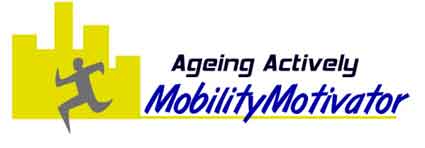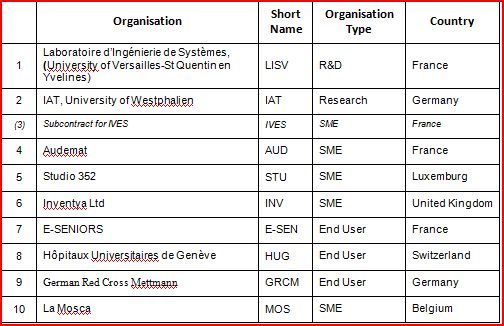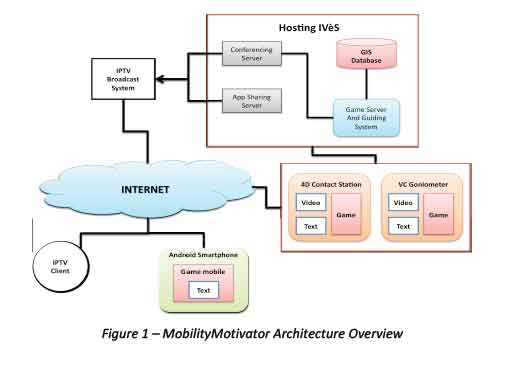
MOBILITY MOTIVATOR Project
AAL CALL 4
 |
MOBILITY MOTIVATOR Project AAL CALL 4 |
Application areas addressed: Mobility, Itinerary planning, Orientation, Serious Gaming and Active Aging
Proposal full title: A motivating game-like environment and
information system for the promotion and monitoring of mobility and cognitive
skills amongst elderly people with chronic diseases.
Proposal acronym: MobilityMotivator
Name of the lead
coordinator person: Dr. Marie-Madeleine Bernard
Contact details of
the coordinator: mmb@pace2000.org
List of
participants:

Mobility is key, not only to ageing well, but
to the control of most prevalent chronic diseases including the “diabesity” pandemic. Lack of involvement in regular
physical activity is an important challenge and the cause for many therapeutic
failures, particularly amongst elderly people who suffer from chronic diseases,
but should also be countered as a preventive measure to delay the onset of
these conditions.
Correcting situational disadvantages generated by chronic diseases and
providing a multi-player environment are important factors promoting active
ageing and mobility. PACE 2000’s ten years of operations of tele-physiotherapy
sessions with inter-generational participation (Published evaluations attached), indicate that the teaming of participants is key to the
success of long term mobility. The
difficulties of conserving mobility and autonomy to do shopping and see friends
outside the home are also linked to physical capacity, including choosing the
optimum route and fighting the fear of getting lost. These can be solved by
providing itinerary planning coupled with a mobile interface such as a smart
phone acting as a companion as well as an element of the game which can be
adapted to the needs of the person and the method of displacement (walking, in
a chair or mobility scooter, public transport etc..)
The aim in project MobilityMotivator is to
design and develop a multiplayer multifunctional interactive and engaging
environment promoting in- and out-door mobility amongst elderly people (primary
users) who need incentives to
maintain an active lifestyle or who suffer from chronic diseases.
Furthermore, the MobiliyMotivator solution will
provide those for whom the care and welfare of the elderly end user is of
particular concern, (i.e. secondary user) with monitoring mechanisms to assess
range of motion and cognitive skills. The mobile interface will also track
activities of the person which can be consulted by family members or carers at
different levels of detail to verify that all is going well.
MobilityMotivator will integrate a range of state of
the art technologies such as a “4D Contact Point” Station (Simultaneous
1-Verbal 2- Non verbal communication 3- reading 4- writing) and a Video-conference-based
GoniometerÒ into a multi-player gaming
environment to provide a truly innovative approach to promoting mobility and
the exercising of cognitive skills amongst the primary user target base. The
solution will be accessible on IP-TV as well as PC and tablets. The itinerary planning
interface coupled with the mobile interface will integrate detailed
geographical data permitting all obstacles, gradients, stairs and surfaces of
the route to be stored and used in the calculation of the optimum itinerary
taking into account the deficiencies of the user.
The MobilityMotivator consortium has agreed on
the following strategic objectives (SOs):
SO1 Define user driven specifications for an
interactive and engaging serious gaming environment to promote and monitor
mobility and cognitive skills amongst elderly people with chronic diseases in
the community.
SO2 Identify a comprehensive range of user needs
and interests upon which to base the design and development of user driven
content and interaction mechanisms.
SO3 Develop a low cost, customized and integrated
MobilityMotivator environment incorporating
accessible static and mobile itinerary
planning interfaces and
multiplayer games favouring indoor and outdoor mobility, a « 4D contact » station
to facilitate multi-user collaboration and a videoconference GoniometerÒ for measuring the range of motion in the
indoor environment.
SO4 Design
tailored interfaces and interaction systems adapted to the users’ needs and
requirements that facilitate assessment of mobility and cognitive skills and produce or adapt GIS and other data
enabling the extension to the outdoor environment in the pilot test sites.
SO5 Produce
a set of content specifications that will guide the game development process
and build pilot content scenarios for user assessment.
SO6 Install the MobilityMotivator
technology to be evaluated by a
representative sample of users in each of the 3 centers for elderly people in
France, switzerland and the
Netherlands.
SO7 Elaborate a methodology for assessing the
socio-economic and organizational impact of MobilityMotivator
on user groups and conduct this assessment through the use of assessment tools
designed for that purpose.
SO8 Implement an exploitation and dissemination
strategy and plan including a MobilityMotivator
Community of Practice (MMCoP) to build awareness and
prepare for commercialization.
SO9 Open new revenue opportunities for elderly
care service providers by creating a new, interactive approach for promoting
mobility in a distributed environment.
SO10 Explore ways in which services for the elderly
could be co-financed from new revenue streams through partnerships between
private and public sectors.
The work plan in project MobilityMotivator
will run for a period of 36 months and include the following key areas of
activity:
WP1 – Project Management and Coordination
WP2 – User Requirements Identification and Monitoring
WP3 – MobilityMotivator Environment Design,
Development and Integration
WP4 – Pilot Test Cases
WP 5 - Dissemination and Exploitation
At project completion, the consortium will have
a comprehensive mobility solution, tested and validated, ready for
commercialisation
Multiplayer Game Mobility Motivator
The game
presents a choice of competitivity or collaboration
amongst players. One setting allows for
the collaboration between an outdoor “explorer” using a smartphone, and an in-door “researcher”
using a PC or tablets.
The
selected framework is the participants’ local area map (Google map or the
CEREMH accessible map). Players choose
an itinerary with achievable distance.
Similar to
a “snake and ladder” game,
participants want to reach their destination in minimum time with
maximum rewards.
Questions
are focused on recognizing landmarks, identifying difficulties (series of steps , absence of walkway etc…) or performing a movement or
adopting the shadow of a posture. Simple
or elaborate orientation questions (Cardinal points, distance remaining etc…)
will be addressed
by discussing them amongst the paired players.
Some goals cannot be attained without collaboration amongst partners.
Architecture du système
